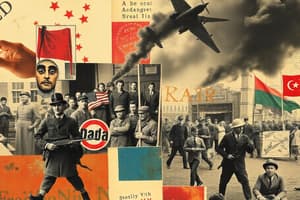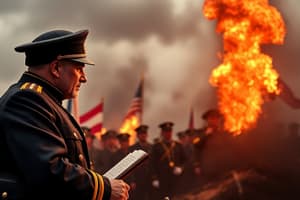Podcast
Questions and Answers
Intense pride and loyalty to one's nation is known as ______.
Intense pride and loyalty to one's nation is known as ______.
nationalism
The competition for colonies and resources that intensified tensions was referred to as ______.
The competition for colonies and resources that intensified tensions was referred to as ______.
imperialism
A massive build-up of military forces and the glorification of war is termed ______.
A massive build-up of military forces and the glorification of war is termed ______.
militarism
The assassination of Archduke Franz Ferdinand triggered a chain reaction leading to World War I, starting with an ultimatum from ______.
The assassination of Archduke Franz Ferdinand triggered a chain reaction leading to World War I, starting with an ultimatum from ______.
The complex network of alliances involved nations pledging to defend one another, including the ______ and the Triple Entente.
The complex network of alliances involved nations pledging to defend one another, including the ______ and the Triple Entente.
Trench warfare on the Western Front created a ______ that lasted much of World War I.
Trench warfare on the Western Front created a ______ that lasted much of World War I.
On the Eastern Front, the war was characterized by large-scale battles and shifts in ______.
On the Eastern Front, the war was characterized by large-scale battles and shifts in ______.
Machine guns were a significant technological advancement that caused massive casualties on the ______.
Machine guns were a significant technological advancement that caused massive casualties on the ______.
Tanks were introduced in WWI to break through enemy lines and attack entrenched ______.
Tanks were introduced in WWI to break through enemy lines and attack entrenched ______.
The use of ______ gas marked a horrific development in chemical warfare during WWI.
The use of ______ gas marked a horrific development in chemical warfare during WWI.
Airplanes were initially utilized for reconnaissance and gradually evolved into ______ roles.
Airplanes were initially utilized for reconnaissance and gradually evolved into ______ roles.
The war led to mass ______, requiring large numbers of soldiers and civilians to support the war effort.
The war led to mass ______, requiring large numbers of soldiers and civilians to support the war effort.
The Treaty of ______ officially ended WWI and imposed severe penalties on Germany.
The Treaty of ______ officially ended WWI and imposed severe penalties on Germany.
Germany was forced to pay large-scale ______ to the Allied powers after WWI.
Germany was forced to pay large-scale ______ to the Allied powers after WWI.
The rise of ______ in Russia was one of the significant long-term consequences of WWI.
The rise of ______ in Russia was one of the significant long-term consequences of WWI.
The League of ______ was established in an attempt to promote international peace and cooperation after WWI.
The League of ______ was established in an attempt to promote international peace and cooperation after WWI.
Flashcards
Nationalism
Nationalism
Intense national pride and loyalty that fueled rivalries and conflicts between European powers.
Imperialism
Imperialism
Competition for overseas territories and resources, intensifying tensions between European nations.
Militarism
Militarism
The massive build-up of military forces and glorification of war, leading to a climate of fear and suspicion.
Alliance System
Alliance System
Signup and view all the flashcards
Assassination of Archduke Franz Ferdinand
Assassination of Archduke Franz Ferdinand
Signup and view all the flashcards
Ultimatum from Austria-Hungary to Serbia
Ultimatum from Austria-Hungary to Serbia
Signup and view all the flashcards
Declarations of War
Declarations of War
Signup and view all the flashcards
Western Front
Western Front
Signup and view all the flashcards
Tanks in WWI
Tanks in WWI
Signup and view all the flashcards
Poisonous Gases in WWI
Poisonous Gases in WWI
Signup and view all the flashcards
Airplanes in WWI
Airplanes in WWI
Signup and view all the flashcards
Mass Mobilization in WWI
Mass Mobilization in WWI
Signup and view all the flashcards
Economic Impact of WWI
Economic Impact of WWI
Signup and view all the flashcards
Social Impact of WWI
Social Impact of WWI
Signup and view all the flashcards
Treaty of Versailles
Treaty of Versailles
Signup and view all the flashcards
Long-term consequences of the Treaty of Versailles
Long-term consequences of the Treaty of Versailles
Signup and view all the flashcards
Study Notes
Causes of World War I
- Nationalism: Intense pride and loyalty to one's nation fueled rivalries and conflicts between European powers. Nationalist movements sought independence and territorial expansion, often at the expense of others.
- Imperialism: Competition for colonies and resources intensified tensions between European nations. Control over overseas territories provided economic and strategic advantages, leading to clashes over resources and influence.
- Militarism: A massive build-up of military forces and the glorification of war created a climate of fear and suspicion. Arms races and the development of new technologies heightened tensions and the possibility of conflict.
- Alliance system: A complex network of alliances obligated countries to defend one another. A single conflict could quickly escalate into a broader war involving multiple nations. The Triple Alliance (Germany, Austria-Hungary, Italy) and the Triple Entente (France, Russia, Britain) were significant players.
Immediate Causes
- Assassination of Archduke Franz Ferdinand: The assassination of the Austrian Archduke Franz Ferdinand by a Serbian nationalist triggered a chain reaction that led to the outbreak of war.
- Ultimatum from Austria-Hungary to Serbia: Following the assassination, Austria-Hungary issued an ultimatum to Serbia, demanding concessions that Serbia found unacceptable.
- Declarations of war: Austria-Hungary declared war on Serbia, triggering the mobilization of other nations due to the alliances, ultimately drawing Europe into a large-scale war. Russia mobilized in support of Serbia, followed by Germany and France.
Key Fronts
- Western Front: Characterized by trench warfare, a stalemate that lasted much of the war. Large-scale battles were costly and resulted in high casualties.
- Eastern Front: A more fluid front, featuring large-scale battles and shifts in position. The war on the Eastern Front was marked by a complex mix of Russian offensives and counteroffensives.
- Other Fronts: Battles and conflicts outside of the Western and Eastern Fronts occurred in other parts of Europe, the Middle East, and various colonial holdings.
Technological Advancements
- Machine guns: These weapons caused massive casualties on the battlefield, contributing significantly to the high numbers of deaths in trench warfare.
- Tanks: Introduced in WWI, these vehicles were used to break through enemy lines and attack entrenched positions, demonstrating an early form of armored warfare.
- Poison gas: Used as a weapon for the first time in history, chemical warfare was particularly significant and horrific in its effects on soldiers.
- Airplanes: Used for reconnaissance and gradually for bombing roles, this was an early form of aerial combat.
Societal Impact
- Mass mobilization: War efforts demanded the mobilization of massive numbers of soldiers and civilians to support the war effort, dramatically impacting societies.
- Economic consequences: The war led to significant economic disruption and instability, with widespread destruction of infrastructure and resources.
- Social changes: The war led to profound societal changes, including women entering the workforce, increased social consciousness, and altered views on nationalism.
Key Figures
- Kaiser Wilhelm II: The German Emperor during World War I.
- Woodrow Wilson: The President of the United States during World War I.
- Georges Clemenceau: The French Premier during World War I.
- Tsar Nicholas II: The Russian Tsar during World War I.
Treaty of Versailles
- Treaty that officially ended WWI, imposing severe penalties on Germany.
- Territorial losses: Germany lost significant territory.
- Military restrictions: Germany's army and navy were severely limited.
- Reparations: Forced to pay large-scale reparations to the Allied powers. This imposed a great economic burden on Germany and was a major factor contributing to the conditions that facilitated the rise of Nazism.
Long-Term Consequences
- Rise of communism in Russia: The war's impact contributed to the Russian Revolution and the establishment of a communist state.
- Political instability in Europe: The war's consequences led to political upheaval and instability in numerous European countries.
- League of Nations: Attempts to establish international peace and cooperation through international institutions.
- Seeds of future conflict: The treaty and its controversial terms sowed seeds of resentment and fueled future conflicts, particularly in Europe.
Studying That Suits You
Use AI to generate personalized quizzes and flashcards to suit your learning preferences.




